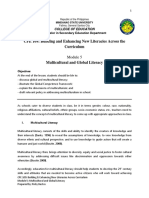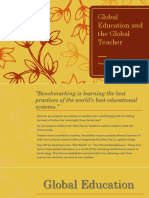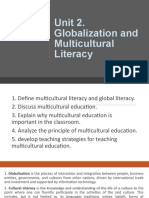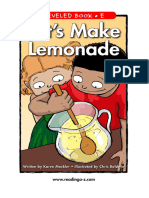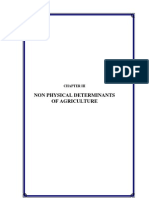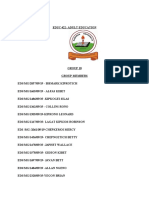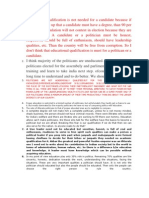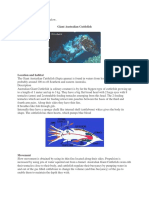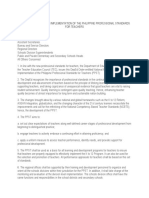LC-5 Ped 10
LC-5 Ped 10
Uploaded by
Renave MaeCopyright:
Available Formats
LC-5 Ped 10
LC-5 Ped 10
Uploaded by
Renave MaeOriginal Title
Copyright
Available Formats
Share this document
Did you find this document useful?
Is this content inappropriate?
Copyright:
Available Formats
LC-5 Ped 10
LC-5 Ped 10
Uploaded by
Renave MaeCopyright:
Available Formats
lOMoARcPSD|37500778
Module 5:
MULTICULTURAL AND GLOBAL LITERACY
I. CONCEPT EXPLORATION
As schools cater to diverse students in class, be it in terms of gender, color, race, nationality, religious
affiliations, cultural beliefs, ethnic groups, socio-economic status, etc., teachers need to understand the concept
of multicultural literacy to come up with appropriate approaches in class.
II. LEARNING OBJECTIVES:
1. Discuss global and multicultural literacy.
2. Illustrate the Global Competence Framework
3. Explain the dimensions of multiculturalism
4. Elucidate on the assessment strategy for global competence and global understanding
5. Present effective ways on how to integrate global multiculturalism in the lesson using appropriate delivery
strategies, instructional materials and assessment tools.
6. Draw relevant life lessons and significant values from personal experience in demonstrating multicultural
literacy
7. Analyze research abstract on global and multicultural literacy and its implications on the teaching-learning
process
8. Draft relevant policy in addressing multiculturalism in school
III. ABSTRACTION
Multicultural Literacy
Multicultural literacy consists of the skills and ability to identify the creators of knowledge and their interests
(Banks, 1996) to reveal the assumptions of knowledge, to view knowledge from diverse ethnic and cultural
perspective, and to use knowledge to guide action that will create a humane and just world (Boutte, 2008).
Multicultural literacy then, brings attention to diversity, equity and social justice to foster cultural awareness
by addressing difficult issues like discrimination and oppression towards other ethnicities (Boutte, 2008).
Accordingly, education for multicultural literacy should help students to develop the 21 st century skills and
attitudes that are needed to active citizens who will work toward achieving social justice within communities.
Because of the growing racial, language and ethnic diversity in the country, multicultural literacy needs to be
transformed in substantial ways to prepare students to function effectively in the 21 st Century (Boutte).
Boutte (2008) reiterated that making small changes within the classrooms can create big changes globally. As
diversity grows, there is a need for the emergence of multicultural education that is more representative of the
students in today’s classrooms. Banks (2003) asserted that teaching students to be advocates of multiculturalism
is also a matter of sending a message of empathy and tolerance in schools to develop a deeper understanding of
others and appreciation of different cultures. Developing these attitudes and skills requires basic knowledge
prior to teaching students how to question assumptions about cultural knowledge and how to critique and
critically think about these important cultural issues, which is what essentially makes multicultural literacy a 21 st
Century literacy (Banks, 2003).
Global Literacy
Global literacy aims to address issues of globalization, racism, diversity and social justice (Guo, 2014). It
requires awareness and action, consistent with a broad understanding of humanity, the planet, and the impact
of a human decision on both. It also aims to empower students with knowledge and take action to make a
positive impact in the world and their local community (Guo, 2014).
According to the Ontario Ministry of Education (2015), a global citizen should possess the following
characteristics: (1) respect for humans regardless of race, gender, religion or political perspectives; (2) respect for
diversity and various perspectives; (3) promote sustainable patterns of living, consumption, and production; and
(4) appreciate the natural world and demonstrate respect on the rights of all living things.
Interconnecting multicultural and global literacy. Every classroom contains students of different races,
religions and cultural groups. Guo (2014) averred that students embrace diverse behaviors, cultural values,
patterns of practice, and communication, yet they all share one commonality, which is their educational
opportunity.
Therefore, teachers should teach their students that other cultures exist and that these deserve to be
acknowledged and respected. Integrating a variety of cultural context into lessons and activities teaches students
Downloaded by Renave Mae Limpiado (limpiadorenavemae@gmail.com)
lOMoARcPSD|37500778
to view the world from many angles, creates respect for diversity and enables students to learn exciting
information. As classrooms become increasingly more diverse, it is important for educators to analyze and
address diversity issues and integrate multiculturalism information into the classroom curriculum (Guo, 2014).
The OECD Global Competence Framework
The framework depicts the four dimensions of global competence encompassing the development of knowledge,
values, attitude and skills that flow along parameters of attaining such competency.
Global Competence
The desire to participate in interconnected, complex and diverse societies has become a pressing need.
Recognizing the roles of schools in preparing the youth to participate in the world, the OECD’s Program for
International Student Assessment (PISA) developed a framework to explain, foster and assess students’ global
competence. This design serves as a tool for policymakers, leaders and teachers in fostering global competence
among students worldwide.
Global competence is a multidimensional capacity. Therefore, globally competent individuals can analyze
and rationalize local, global and intercultural issues, understand and appreciate different perspectives and
worldviews, interact successfully and respectfully with others, and take responsible action toward sustainability and
collective well-being (OECD publication).
Global competence refers to skills, values and behaviors that prepare young people to thrive in a diverse,
interconnected and rapidly changing world. It is the ability to become engaged citizens and collaborative problem
solvers who are ready for the workforce.
Promoting global competence in schools. Schools play a crucial role in helping young people to develop
global competence. They can provide opportunities to critically examine global developments that are significant to
both the world and to their own lives. They can teach students how to critically, effectively and responsibly use
digital information and social media platforms.
Schools can encourage intercultural sensitivity and respect by allowing students to engage in experiences
that foster an appreciation for diverse peoples, languages and cultures (Bennett, 1993; Sinicrope, Norris and
Watanabe, 2007). Schools are also positioned to enhance students’ ability to understand their place in the
community and the world and improve such ability to make judgments and take action (Hanvey, 1975 in PISA,2018).
The Need for Global Competence
The following are the reasons why global competence is necessary.
1. To live harmoniously in multicultural communities. Education for global competence can promote
cultural awareness and purposeful interactions in increasingly diverse societies (Brubacker and Laitin,
1998; Kymlicka, 1995; Sen, 2007). People with diverse cultures are able to live peacefully, respect
differences, find common solutions, resolve conflicts and learn to live together as global citizens (Delors,
et. al., 1996; UNESCO, 2014b). Thus, education can teach students the need to address cultural biases
and stereotypes.
Downloaded by Renave Mae Limpiado (limpiadorenavemae@gmail.com)
lOMoARcPSD|37500778
2. To thrive in a changing labor market. Education for global competence can boost employability through
effective communication and appropriate behavior within diverse teams using technology in accessing
and connecting to the world (British Council, 2013).
3. To use media platforms effectively and responsibly. Radical transformations in digital technologies have
shaped young people’s outlook on the world, their interaction with others and perception of themselves.
Online networks, social media and interactive technologies give rise to new concepts of learning,
wherein young people exercise to take their freedom on what and how they learn (Zuckerman, 2014).
4. To support the sustainable development goals. Education for global competence can help form new
generations who care about global issues and engage in social, political, economic and environmental
discussions.
Dimensions of Global Competence: Implications to Education
Education for global competence is founded on the ideas of different models of global education,
such as intercultural education, global citizenship education and education for democratic citizenship
(UNESCO, 2104a; Council of Europe, 2016a).
Despite differences in focus and scope, these models share a common goal of promoting students’
understanding of the world and empower them to express their views and participate in the society. PISA
proposes a new perspective on the definition and assessment of global competence that will help policy
makers and school leaders create learning resources and curricula that integrate global competence as a
multifaceted cognitive, socio-emotional and civic learning goal (Boix Mansilla, 2016).
This definition outlines four dimensions of global competence that people need to apply in their
everyday life just like students from different cultural backgrounds are working together on school projects.
Dimension 1: Examine issues of local, global and cultural significance
This dimension refers to globally competent people’s practices of effectively utilizing knowledge
about the world and critical reasoning in forming their own opinion about a global issue. People, who acquire
a mature level of development in this dimension, use higher-order thinking skills, such as selecting and
weighing appropriate evidence to support arguments about global developments. Most likely, globally
competent students can draw on and combine the disciplinary knowledge and thinking styles learned in
schools to ask questions, analyze data and propositions, explain phenomena, and develop a position
concerning a local, global or cultural issue. Hence, globally competent people effectively use and create both
traditional and digital media (Boix Mansilla and Jackson, 2011).
Dimension 2: Understand and appreciate the perspectives and world views of others
This dimension highlights that globally competent people are willing and capable of considering
other people’s perspectives and behaviors from multiple viewpoints to examine their own assumptions. This
in turn, implies a profound respect for and interest in others with their concept of reality and emotions.
Individuals with this competence also consider and appreciate the connections that enable them to bridge in
differences and create common ground. They retain their cultural identity while becoming awareof the
cultural values and beliefs of people around them (Fennes and Hapgood, 1997).
Dimension 3: Engage in open, appropriate and effective interactions across cultures
This dimension describes what globally component individuals can do when they interact with
people from different cultures. They understand the cultural norms, interactive styles and degrees of
formality of intercultural contexts, and they can flexibly adapt their behavior and communication manner
through respectful dialog even with marginalized groups. Therefore, it emphasizes individuals’ capacity to
interact with others across differences in ways that are open, appropriate and effective (Barrett, et. al.,
2014).
Dimension 4: Take action for collective well-being and sustainable development
This dimension focuses on young people’s role as active and responsible members of society and
refers to individual’s readiness to respond to a given local, global or intercultural issue or situation. It
recognizes that young people have multiple realms of influence ranging from personal and local to digital and
global. Globally competent people create opportunities to get engaged to improve living conditions in their
communities and build a just, peaceful, inclusive and an environmentally sustainable world.
The Assessment strategy for global competence
The PISA 2018 assessment of global competence contributes development while considering
challenges and limitations. It has two components: 1) a cognitive test exclusively focused on the construct of
“global understanding”; and
Downloaded by Renave Mae Limpiado (limpiadorenavemae@gmail.com)
lOMoARcPSD|37500778
2) a set of questionnaire items collecting self-reported information and students’ awareness on global issues
and cultures, skills (both cognitive and social) and attitudes, as well as information from schools and teachers
on activities that promote global competence (OECD, 2018).
Curriculum for global competence: Knowledge, skills, attitudes and values
Schools can provide opportunities for students to explore complex global issues that they encounter
through media and their own experiences. The curriculum should focus on four knowledge domains: (1)
culture and intercultural relations; (2) socio-economic development and interdependence; (3) environmental
sustainability; and (4) global institutions, conflicts and human rights. Teaching these four domains should
stress on differences in perspectives, questioning concepts, and arguments. Students can acquire knowledge
in this domain by reflecting their own cultural identity and that of their peers by analyzing common
stereotypes toward people in their community or by analyzing related cases of cultural conflict. Acquiring
knowledge in this aspect is important in developing values such as peace, respect, non-discrimination,
equality, fairness, acceptance, justice, non-violence and tolerance (OECD, 2018).
Skills to understand the world and to take action
Global competence builds on specific cognitive, communication and socio-emotional skills. Effective
education for global competence gives students the opportunity to mobilize and use their knowledge,
attitudes, skills and values together while sharing ideas on global issues in and outside of school or
interacting with people from different cultural backgrounds.
A school community that desires to nurture global competence should focus on clear, controllable
and realizable learning goals. This means engaging all educators to reflect on teaching topics that are globally
significant, the types of skills that foster deeper understanding of the world and facilitate respectful
interactions in multicultural contexts, and attitudes and values that drive autonomous learning and inspirable
responsible action (OECD, 2018).
Knowledge about the world and other cultures
Global competence is supported by the knowledge of global issues that affect lives locally and
around the globe, as well as intercultural knowledge, or knowledge about the similarities, differences and
relations among culture. This knowledge helps people to challenge misinformation and stereotypes about
other countries and people, and thus, results in intolerance and oversimplified representations of the world.
This can be done through the following strategies (OECD, 2018):
Perspective-taking refers to the cognitive and social skills of understanding how other people think
and feel.
Adaptability refers to the ability to adapt systems thinking and behaviors to the prevailing cultural
environment, or to situations and contexts that can present new demands or challenges.
Openness, respect for diversity and global-mindedness
Globally competent behavior requires an attitude of openness towards people from other cultural
backgrounds, an attitude of respect for cultural differences and an attitude of global-mindedness. Such attitudes can
be fostered explicitly through participatory and learner-centered teaching, as well as through a curriculum
characterized by fair practices and an accommodating school climate for all students.
Openness toward people from other cultural backgrounds involves sensitivity towards curiosity about and
willingness to engage with other people and other perspectives on the world (Byram, 2008; Council of Europe,
2016a).
Respect consists of a positive regard for someone based on judgement of intrinsic worth. It assumes the
dignity of all human beings and their inalienable right to choose their own affiliations, beliefs, opinions, or practices
(Council of Europe, 2016a).
Global-mindedness is defined as a worldview, in which one sees him/herself connected to the community
and feels a sense of responsibility for its members (Hansen, 2010).
Valuing human dignity and diversity
Valuing human dignity and valuing cultural diversity contribute to global competence because they
constitute critical filters through which individuals process information about other cultures and decide how to
Downloaded by Renave Mae Limpiado (limpiadorenavemae@gmail.com)
lOMoARcPSD|37500778
engage with others and the world. Hence, people, who cultivate these values, become more aware of themselves
and their surroundings, and are strongly motivated to fight against exclusion, ignorance, violence, oppression and
war.
Clapham (2006) introduced the four aspects of valuing equality of core rights and dignity. To wit: (1) the
prohibition of all types of inhuman treatment, humiliation or degradation by one person over another; (2) the
assurance of the possibility for individual choice and the conditions for each individual’s self-fulfillment, autonomy,
or self-realization; (3) the recognition that protection of group identity and culture may be essential for that of
personal dignity; and (4) the creation of necessary conditions to have the essential needs satisfied.
Global understanding
Understanding is the ability to use knowledge to find meaning and connection between different pieces of
information and perspectives.
The framework distinguishes four interrelated cognitive processes that globally competent students need to
use to understand fully global or intercultural issues and situations (OECD, 2018).
1. The capacity to evaluate information, formulate arguments and explain complex situations and problems by
using and connecting evidence, identifying biases and gaps in information and managing conflicting
arguments.
2. The capacity to analyze multiple perspectives and worldviews, positioning and connecting their own and
others’ perspectives on the world.
3. The capacity to understand differences in communication, recognizing the importance of socially appropriate
communication and adapting it to the demands of diverse cultural contexts.
4. The capacity to evaluate actions and consequences by identifying and comparing different courses of action
and weighing actions on the basis of consequences.
Thus, globally competent students should be able to perform a wide variety of tasks utilizing different
cognitive processes, such as: reasoning with evidence about an issue or situation of local, global and
intercultural significance; searching effectively for useful sources of information; evaluating information on
the basis of its relevance and reliability; synthesizing information to describe the main ideas in an
argumentative text or the salient passages of a conversation; and combining their background knowledge,
new information and critical reasoning to build multi-casual explanations of global or intercultural issues
(OECD, 2018).
Integrating Global and Intercultural Issues in the Curriculum
For global education to translate abstraction into action, there is a need to integrate global issues
and topics into existing subjects (Klein, 2013; UNESCO, 2014). In practice, content knowledge related to
global competence is integrated in the curriculum and taught in specific courses. Therefore, students can
understand those issues across ages, starting in early childhood when presenting them in developmentally
appropriate ways (Boix Mansilla and Jackson, 2011; UNESCO 2015).
Therefore, Gaudelli (2006) affirmed that the teachers must have clear ideas on global and
intercultural issues that students may reflect on. They also need to collaboratively research topics and
carefully design the curriculum while giving students multiple opportunities to learn those issues. Teachers
may also engage in professional learning communities and facilitate peer learning.
More so, teaching about minority cultures on different subject areas entails accurate content
information about ethnically and racially diverse groups and experiences. Curricula should promote the
integration of knowledge of other people, places and perspectives in the classroom throughout the year
(UNESCO, 2014a), rather than using “tourist approach”, or giving students a superficial glimpse of life in
different countries now and then.
Textbooks and other instructional materials can also distort cultural and ethnic differences (Gay,
2015). Teachers and their students should critically examine textbooks and other teaching resources and
supplement information when necessary.
Connecting global and intercultural topics to the reality, contexts and needs of the learning group is
an effective, methodological approach to make them relevant to adolescents (North-South Centre of the
Council of Europe, 2012). People learn better and become more engaged when they get connected with the
content and when they see its relevance to their lives and their immediate environment (Suarez-Orozco and
Todorova, 2008)
Pedagogies for promoting global competence.
Downloaded by Renave Mae Limpiado (limpiadorenavemae@gmail.com)
lOMoARcPSD|37500778
Various student-centered pedagogies can help students develop critical thinking along global issues,
respectful communication, conflict management skills, perspective taking and adaptability.
Group-based cooperative project can improve reasoning and collaborative skills. It involves topic, or
theme-based tasks suitable for various levels and ages, in which goals and content are negotiated and
learners can create their own learning materials that they present and evaluate together. Learners,
participating in cooperative tasks, soon would realize that to be efficient, they need to be respectful,
attentive, honest and emphatic (Barrett, et. al., 2014).
Class discussion is an interactive approach that encourages proactive listening responding to ideas
expressed by peers. By exchanging views in the classroom, students learn that there is no single right answer
to a problem, understand the reasons why others hold different views and reflect on the origins of their own
beliefs (Ritchhart, et. al., 2011)
Service learning is another tool that can help students develop multiple global skills through
realworld experience. This requires learners to participate in organized activities that are based on what has
been learned in the classroom and that benefit their communities. After the activities, learners reflect
critically on their service experience to gain further understanding of course content, and enhance their
sense of role in society with regard to civic, social, economic and political issues (Bringle and Clayton, 2012).
Through service learning, students not only “serve to learn,” which is applied learning, but also “learn to
serve” (Bringle, et. al., 2016).
The Story Circle Approach intends students to practice key intercultural skills, including respect,
culture self-awareness and empathy (Deardorff, n.d.). The students in groups of 5-6 take turns in sharing a
3minute story of their own experience based on specific prompts, such as “Tell us about your first experience
when you encountered someone who was different from you in some ways.” After all students in the group
have shared their personal stories, students then, share the most memorable point from each story in a
“flash back” activity.
Other types of intercultural engagements involve simulations, interviews, role plays and online
games.
Attitudes and values integration toward global competence.
Allocating teaching time to a specific subject that deals with a human rights issues and non-discrimination is
an important initial step in cultivating values for global competence.
Values and attitudes are partly communicated through the formal curriculum and also through ways,
in which teachers and students interact, how discipline is encouraged and the types of opinions and behavior
that are validated in the classroom. Therefore, recognizing the school and classroom environments’ influence
on developing students’ values would help teachers become more aware of the impact of their teaching on
students (Gay, 2015).
QUESTIONS FOR DISCUSSION
1. What are the multicultural global
literacies? 2. Explain the Global Competence
Framework.
3. What are the dimensions of multiculturalism? Explain each.
4. How can global competence and global understanding be assessed in the classroom?
5. How can you integrate multicultural and global literacies in the lesson using appropriate delivery
strategies, assessment tools and instructional materials?
IV. JOURNAL WRITING
Life and Values Integration
Share a personal experience in demonstrating global and multicultural literacies. What life lessons and values
have you realized and learned?
RESEARCH ANALYSIS AND IMPLICATION
Direction: Analyze the following research abstract and cite its implication on teaching- learning. You may
download the full paper of this research on the website given below.
Improving student engagement and acceptance using multicultural texts.
Rouse (2018)
Downloaded by Renave Mae Limpiado (limpiadorenavemae@gmail.com)
lOMoARcPSD|37500778
The purpose of this research is to investigate how students in a third-grade classroom engage in
multicultural texts when reading about cultures other than their own. Furthermore, it investigated how the
use of multicultural texts impacts their understanding and acceptance of diverse cultures. The strategies
used for this qualitative research study were questionnaires, observations, accountable talk discussions,
artifact analysis, and interviews. Throughout, the six week study, students read and engaged in discussions
after reading two multicultural texts. They participated in activities expressing their thoughts and beliefs
related to the content read in class. After discussing and analyzing the texts, students were able to identify
possible solutions to help people become more aware and accepting of diverse cultures. They also become
more engaged in productive dialog with their peers while analyzing and responding to complex texts.
Furthermore, students felt safe and comfortable asking questions about culture and diversity. They were
eager to express their thoughts, interacted with their peers positively and made connections to the
multicultural texts showing their enthusiasm as they learned about different cultures.
(Source: Rouse, B. (2018). Improving student engagement and acceptance using multicultural texts. Theses
and dissertations. https://rdw.rowan.edu/etd/2499.)
Analysis: How can the use of multicultural texts impact students’ understanding and acceptance of diverse
cultures?
Implication: How can this study contribute to the school’s practice of multiculturalism?
SYNTHESIS AND LEARNING REFLECTION
GLOBAL AND MULTICULTURAL LITERACIES
˃ Multicultural literacy depicts diversity, equity and social justice to foster cultural awareness
on discrimination and oppression toward other ethnicities.LEARNING REFLECTION
˃ Global literacy aims to address issues of globalization, racism, diversity and social
justice.
˃ Global competence refers to the skills, values, and behaviors that prepare young
people to thrive in a more diverse, interconnected world, engaged citizens and
collaborative problem solvers who are ready for the workforce.
˃ Globally competent individuals can examine local, global and intercultural issues,
understand and appreciate different perspectives and world views, interact
successfully and respectfully with others, and take responsible action toward
sustainability and collective well-being.
˃ The Global Competence Framework is designed as a tool for policymakers,
leaders, and teachers in nurturing global competence among young people
worldwide with four salient dimensions.
˃ In order to attain respect for diversity in the classroom, teachers should integrate
global multiculturalism in the lesson by citing relevant issues to be addressed.
Downloaded by Renave Mae Limpiado (limpiadorenavemae@gmail.com)
You might also like
- Module 3 Multicultural and Global LiteracyDocument21 pagesModule 3 Multicultural and Global LiteracyJM Paguigan100% (8)
- Reo Manansala - Guro-21-Module-1Document37 pagesReo Manansala - Guro-21-Module-1REO LYNN APRIL MANANSALA83% (6)
- John Guillory - How Scholars ReadDocument10 pagesJohn Guillory - How Scholars Readakrobata1No ratings yet
- TRM Essential English 8 Unit1Document8 pagesTRM Essential English 8 Unit1MarianNo ratings yet
- 2021 ABYIP&2021-2023 CBYDP Tulgao West-1Document13 pages2021 ABYIP&2021-2023 CBYDP Tulgao West-1Angenate Babag95% (20)
- British Columbia - Campus 2020 - Thinking Ahead: The Report - Access & Excellence - The Campus 2020 Plan For British Columbia's Post-Secondary Education System - Geoff Plant - April 2007Document114 pagesBritish Columbia - Campus 2020 - Thinking Ahead: The Report - Access & Excellence - The Campus 2020 Plan For British Columbia's Post-Secondary Education System - Geoff Plant - April 2007climbrandonNo ratings yet
- Module 5 Multicultural and Global Literacy Educ 5Document13 pagesModule 5 Multicultural and Global Literacy Educ 5Jeffrey Jerome Abejero BeñolaNo ratings yet
- Multicultural and Global LiteracyDocument41 pagesMulticultural and Global LiteracyBayu Ubaidillah El-JamalNo ratings yet
- Module 5 MulticulturalDocument13 pagesModule 5 MulticulturalRaciles, Jude Marcel S.No ratings yet
- Globalization and CulturalDocument9 pagesGlobalization and CulturalMa. Lourdes “Ria” VillanuevaNo ratings yet
- Prof Ed 111 Topic 2Document14 pagesProf Ed 111 Topic 2Kryzzia Angellie M. NebitNo ratings yet
- Canillas, Khoebe Kyle S. Unit 4-Globalization and Multicultural LiteracyDocument8 pagesCanillas, Khoebe Kyle S. Unit 4-Globalization and Multicultural LiteracyKyle CanillasNo ratings yet
- Pursue Lesson 1Document10 pagesPursue Lesson 1Cherry Rose J. DeniegaNo ratings yet
- Multicultural LiteracyDocument8 pagesMulticultural LiteracyRaymond DomingoNo ratings yet
- EDUC110 (Multicultural and Global Literacy and SOcial Literacy) Overall ContentDocument23 pagesEDUC110 (Multicultural and Global Literacy and SOcial Literacy) Overall ContentMishelle DayagNo ratings yet
- Module 5 PROF EDUC 10Document44 pagesModule 5 PROF EDUC 10sofijimenoasmaNo ratings yet
- Module 5Document12 pagesModule 5ROSE ANN MAULANANo ratings yet
- Multicultural and Global Literacy ReportDocument33 pagesMulticultural and Global Literacy Reportflorie.vhel2003No ratings yet
- Lesson 6 Multicultural and Global LiteracyDocument37 pagesLesson 6 Multicultural and Global LiteracyMariel Ann Laureta RelotaNo ratings yet
- Multi Cultural and Global LiteracyDocument36 pagesMulti Cultural and Global LiteracyAngel Joy SurellNo ratings yet
- Module 5 Multicultural and Global LiteracyDocument11 pagesModule 5 Multicultural and Global LiteracyJaymark RebosquilloNo ratings yet
- Module 5 John Renier AlmodienDocument15 pagesModule 5 John Renier AlmodienEfigenia Macadaan Fontillas100% (10)
- Interconnecting Multicultural and Global Literacy PPTDocument37 pagesInterconnecting Multicultural and Global Literacy PPTjhiankyletachado98No ratings yet
- College of Teacher EducationDocument5 pagesCollege of Teacher Educationwarner pasaloNo ratings yet
- Module 5 - Multicultural and Global LiteracyDocument10 pagesModule 5 - Multicultural and Global Literacykhaira bai baguilan100% (1)
- LM EDUC Lesson 5Document12 pagesLM EDUC Lesson 5Ace EchavezNo ratings yet
- Prof Ed 5 MidtermDocument25 pagesProf Ed 5 MidtermDojonel ValdezNo ratings yet
- Blue and Yellow Playful Doodle Digital Brainstorm Presentation - 20240609 - 155410 - 0000Document34 pagesBlue and Yellow Playful Doodle Digital Brainstorm Presentation - 20240609 - 155410 - 0000Haydee Cotic CaloNo ratings yet
- Module 5 - Asinas & JungayaDocument44 pagesModule 5 - Asinas & JungayaKhristel AlcaydeNo ratings yet
- Week 6 Multicultural and Global Literacy Specific Intended Learning OutcomesDocument11 pagesWeek 6 Multicultural and Global Literacy Specific Intended Learning OutcomesNova Maria Fe GomezNo ratings yet
- Globalization and Multicultural LiteraciesDocument23 pagesGlobalization and Multicultural LiteraciesAltea Azma NagaNo ratings yet
- Module 5Document43 pagesModule 5Ellaijah Marie AgueranNo ratings yet
- Weeks 5 and 6 Lectures EDUC 6245 (Building... )Document4 pagesWeeks 5 and 6 Lectures EDUC 6245 (Building... )dorothynavidad15No ratings yet
- Multicultural &-WPS OfficeDocument2 pagesMulticultural &-WPS OfficeRenz VenturilloNo ratings yet
- Multicultural and Global LiteracyDocument19 pagesMulticultural and Global LiteracyMeryll Sasalo100% (2)
- Literacy Module 4Document5 pagesLiteracy Module 4Shane GempasaoNo ratings yet
- AnswerDocument8 pagesAnswerAiron Kent TijamNo ratings yet
- ModuleDocument121 pagesModulejocelyn tenorioNo ratings yet
- Benlac ReportingDocument43 pagesBenlac ReportingHaydee Cotic CaloNo ratings yet
- Dcomc ModuleSampleDocument9 pagesDcomc ModuleSampleJhon LoperaNo ratings yet
- Globalization and MulticulturalDocument15 pagesGlobalization and MulticulturalKhenjeza PornelaNo ratings yet
- Module 5Document42 pagesModule 5Wilbert MagdayaoNo ratings yet
- 1 Global and Multicultural LiteracyDocument3 pages1 Global and Multicultural LiteracyWhil Wilson0% (1)
- What Is Global Literacy?Document3 pagesWhat Is Global Literacy?Kristine Jenyl PacificoNo ratings yet
- Module 5. BLDNG & EnhancingDocument10 pagesModule 5. BLDNG & EnhancingJuzzelMarie De-GuzmanNo ratings yet
- The Need For Global CompetenceDocument6 pagesThe Need For Global Competencejolina vitto100% (1)
- Global and Multicultural LiteracyDocument3 pagesGlobal and Multicultural Literacyrollence100% (1)
- MULTICULTURALDocument21 pagesMULTICULTURALRhea Jane TanNo ratings yet
- Media Literacy Skills Education Presentation in Colorful Graphic DesignDocument24 pagesMedia Literacy Skills Education Presentation in Colorful Graphic DesignMievelene ParoNo ratings yet
- Global and Multicultural Literacy 1Document9 pagesGlobal and Multicultural Literacy 1Joshua Dome G. BustamanteNo ratings yet
- Lesson 2 Globalization and Multicultural LiteracyDocument52 pagesLesson 2 Globalization and Multicultural LiteracyRodelin Manding100% (1)
- Chapter 1Document44 pagesChapter 1Vince MartinezNo ratings yet
- Group 2Document35 pagesGroup 2Random PersonNo ratings yet
- Multicultural Literacy or Global UnderstandingDocument7 pagesMulticultural Literacy or Global Understandingalexia domingoNo ratings yet
- College of Teacher EducationDocument2 pagesCollege of Teacher EducationKristine CastleNo ratings yet
- Globalization and Multi-Cultural Literacy and Social LiteracyDocument6 pagesGlobalization and Multi-Cultural Literacy and Social LiteracyPotenciana LongalongNo ratings yet
- Building and Enhancing New Literacies Across The Curriculum: Lomoarcpsd - 5406869Document12 pagesBuilding and Enhancing New Literacies Across The Curriculum: Lomoarcpsd - 5406869Nel BorniaNo ratings yet
- Global and Multicultrual LiteraciesDocument2 pagesGlobal and Multicultrual LiteraciesNORIEL MAE ALIMANo ratings yet
- Educ 6-5Document5 pagesEduc 6-5Rica NarioNo ratings yet
- Jurnal 4 PDFDocument12 pagesJurnal 4 PDFMuhammad BasoriNo ratings yet
- Module 3Document23 pagesModule 3Jeffrey CollantesNo ratings yet
- Profed08 Chapter 5Document8 pagesProfed08 Chapter 5Monica Mae CodillaNo ratings yet
- Preparing Teachers To Educate For 21st Century Global CitizenshipDocument23 pagesPreparing Teachers To Educate For 21st Century Global CitizenshipNurl AinaNo ratings yet
- International Education - International Culture: Education, #1From EverandInternational Education - International Culture: Education, #1No ratings yet
- Calming DownDocument15 pagesCalming DownRenave MaeNo ratings yet
- Raz Cqle29 Toomuchwork (448968)Document2 pagesRaz Cqle29 Toomuchwork (448968)Renave MaeNo ratings yet
- Stop Snoring!Document13 pagesStop Snoring!Renave MaeNo ratings yet
- Let's Make LemonadeDocument13 pagesLet's Make LemonadeRenave MaeNo ratings yet
- Too Much Work!Document11 pagesToo Much Work!Renave MaeNo ratings yet
- LC-3. Phonemes-to-Sound-Patterning-1Document8 pagesLC-3. Phonemes-to-Sound-Patterning-1Renave MaeNo ratings yet
- LC-1. Introduction-to-Stylistics-1Document2 pagesLC-1. Introduction-to-Stylistics-1Renave MaeNo ratings yet
- Unit Plan - GovernmentDocument32 pagesUnit Plan - Governmentapi-396694469No ratings yet
- Sample Literature Review For A Research ProposalDocument4 pagesSample Literature Review For A Research Proposalafdtsdece100% (1)
- Economy Session Part 7 PDFDocument74 pagesEconomy Session Part 7 PDFrohan kumarNo ratings yet
- Let Reviewer For TTLDocument5 pagesLet Reviewer For TTLAngela BetbesNo ratings yet
- Non Physical Factors of AgricultureDocument60 pagesNon Physical Factors of AgricultureDevyani HadaNo ratings yet
- NSTP Thesis TitleDocument4 pagesNSTP Thesis Titleamybakewellfargo100% (1)
- Tikoko 1Document4 pagesTikoko 1Silas KipkogeiNo ratings yet
- Edtpa Ell Assessment CommentaryDocument8 pagesEdtpa Ell Assessment Commentaryapi-664414599No ratings yet
- MIL Module 2ndquarterDocument33 pagesMIL Module 2ndquarterAngel Indira GuiritanNo ratings yet
- Literacy Narrative EssayDocument5 pagesLiteracy Narrative EssaySummer HolmanNo ratings yet
- Computers & Education: Judit García-Martín, Jesús-Nicasio García-S AnchezDocument14 pagesComputers & Education: Judit García-Martín, Jesús-Nicasio García-S Anchezbeatriz cabellosNo ratings yet
- Research ABM Manuscript OriginalDocument40 pagesResearch ABM Manuscript Originalmalaokim bacsarpaNo ratings yet
- Wayana Baseline Study 2007Document207 pagesWayana Baseline Study 2007Pedro Portella MacedoNo ratings yet
- Morocco Complete PaperDocument60 pagesMorocco Complete Paperapi-422621008No ratings yet
- MIL REVIEWER Google DriveDocument25 pagesMIL REVIEWER Google DriveNicole PauigNo ratings yet
- Global Stage 4 Literacy U1-3Document55 pagesGlobal Stage 4 Literacy U1-3Lưu Thanh Tâm0% (1)
- HED Education and Psychology Catalogue PDFDocument60 pagesHED Education and Psychology Catalogue PDFAlex SanchezNo ratings yet
- Literature Review Early Childhood EducationDocument10 pagesLiterature Review Early Childhood Educationafmzzulfmzbxet100% (1)
- DebateDocument3 pagesDebatejatinder_diva100% (3)
- Building and Enhancing New Literacies Across The CurriculumDocument5 pagesBuilding and Enhancing New Literacies Across The CurriculumMaybelleNo ratings yet
- BESRA (Basic Education Sector Reform Agenda) by Reuben Justin M. VittoDocument39 pagesBESRA (Basic Education Sector Reform Agenda) by Reuben Justin M. VittoReuben Justin M. VittoNo ratings yet
- Study Habits Proposal RevisedDocument10 pagesStudy Habits Proposal RevisedTilahun MikiasNo ratings yet
- The 21st Century SkillsDocument20 pagesThe 21st Century SkillsPablo Bulac AtacadorNo ratings yet
- Soal Paket BDocument10 pagesSoal Paket BRizal Rohman NakcDpNo ratings yet
- Philippine Professional Standards For TeachersDocument24 pagesPhilippine Professional Standards For TeachersKram RallavNo ratings yet
























